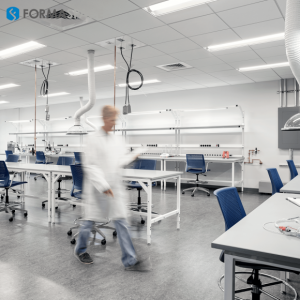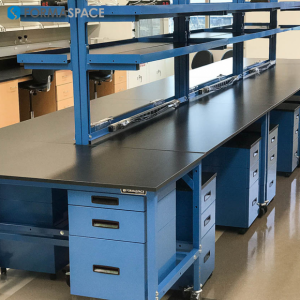How to Start a Laboratory Business from Scratch
Here are the top ten questions you need to ask before launching a new laboratory startup.
The current Covid pandemic has shifted demand across many sectors of the economy, including the lab sector, which makes these economic models and investment calculations more difficult.”
AUSTIN, TEXAS, UNITED STATES, October 1, 2020 /EINPresswire.com/ -- What can you do to make your new laboratory startup venture a success? We take a look at the top 10 questions everyone should ask themselves before green-lighting a new laboratory venture.— Formaspace
1. What Is The Business Case For Your New Laboratory Startup?
Take the time to create a detailed business plan upfront — one that addresses the difficult questions — before expending scarce financial and human resources.
A good place to start is by researching the market demand and identifying the business case for your new venture.
Here are a couple of business case examples – but yours will need to be more detailed, backed up by solid technical and market research.
a) To take advantage of new research/testing opportunities, such as those created by the Covid pandemic.
b) Use new lab technologies to serve unmet demand in the market by out-competing/displacing other laboratories relying on older technology.
2. Who Needs Your Laboratory Services, E.G. Who Is The Customer?
The next step in creating a solid laboratory business plan is to identify “who is the customer?”
In reality, there are often multiple answers to this question, so perhaps we should rephrase the question as “who are the stakeholders?”
Startup laboratories will need to identify what products and services they are offering to prospective customers in the market place.
But they will also need to treat their investors (e.g. the angel and VC firms making substantial upfront investments) as key stakeholders by delivering on the promises they have made in terms of project milestones and product and service deliveries.
3. What Is The Funding Model And Return On Investment (ROI) For Your New Laboratory Project?
In normal times, commercial laboratories with a recurring revenue stream would find answering questions about funding sources and return on investment (ROI) to be fairly straightforward.
However, we don’t live in normal times right now.
The current Covid pandemic has shifted demand across many sectors of the economy, including the lab sector, which makes these economic models and investment calculations more difficult.
For example, demand for clinical healthcare testing (including Covid virus and vaccine trials testing) is up, while demand in other areas (such as petroleum well testing) is down.
This puts additional pressure on lab startups to identify viable funding sources to support the business after the initial funding runs out — by signing long-term customer contracts, obtaining multi-phase government research grants, or pursuing direct sales opportunities, such as direct sales of home testing kits sold to consumers over the internet.
It also puts greater pressure on controlling costs and justifying expenditures.
Fortunately, there are clever, cost-effective solutions available, such as efficient storage and flexible furniture options (such as mobile carts) that can help you get the most use out of your available square footage — while maximizing ROI at the same time.
Some lab startups may also benefit from taking advantage of local startup accelerators, which offer shared workspaces during the early venture stages.
4. Which Regulatory Regimes Will Govern Your Laboratory Operations?
Every business is subject to some form of federal, state, or local regulations.
Broadly speaking, most of these regulations have to do with public safety; for example, does your facility meet fire regulations? Is it structurally sound? Are there enough emergency exits? etc.
In contrast, laboratory facilities tend to be highly regulated, often falling under one or more regulatory regimes that are either mandated by government agencies or set forth by industry trade groups that issue “certifications.”
The intended use of your laboratory will determine which sets of regulations or certification guidelines apply.
For example, laboratories designed for pharmaceutical or food manufacturing testing will need to comply with the FDA’s Current Good Manufacturing Practice (cGMP) regulations.
Laboratories designed to handle potentially dangerous materials are subject to even more stringent regulations. Facilities handling radioactive materials must comply with the Department of Energy regulations, while labs handling potentially dangerous biological pathogens fall under CDC biosafety regulations, which classify labs according to four biosafety levels, BSL-1 through BSL-4.
(Only a few laboratories around the world qualify for the BSL-4 rating, designated for handling the most dangerous pathogens. These labs must incorporate highly redundant safety systems, including isolated clean room chambers where lab personnel wear special PPE, such as “spacesuit” type protective garments.)
5. What Kind Of Lab Facilities Do You Need To Achieve Your Goals?
Now that we’ve identified the business case, the customer, the funding sources, and the regulatory regimes that govern your new laboratory startup, it’s time for the facility project managers to begin working with the architects and designers to develop a list of “architectural programming requirements“ for the new laboratory.
One useful piece of advice: avoid “reinventing the wheel.”
There are many well-documented laboratory designs that can provide inspiration for your projects. Evaluate as many as you can to identify what would work for you and what you’d like to do differently.
Another useful resource is the publication Forensic Science Laboratories: Handbook for Facility Planning, Design, Construction, and Relocation, published by the National Institute of Standards and Technology (NIST). While (as the title suggests) its focus is forensic science laboratories, it clearly documents a set of best practices for managing laboratory construction projects.
From a design perspective, laboratory facilities generally include one or more of these components:
Wet Labs
In the language of laboratory design, wet labs are the areas that handle liquid chemicals. Designers need to pay particular attention to specifying chemically resistant surfaces, a sufficient number of wet sinks (often with their own special waste handling drainage system), as well as fume hoods to protect workers from potential exposure to noxious gases or dangerous particulates.
Dry Labs / Tech Labs
The term “dry lab” traditionally refers to laboratory zones that handle dry chemicals in small amounts.
Thanks to the revolution in scientific computing, however, the role of dry labs has expanded tremendously over the past few decades to incorporate computer systems as well. This has led to the rise of the “tech lab,” where lab researchers access and manage computer workstations or provide IT services to the organization. The computer systems can be a major source of heat, so these areas will usually need beefed up HVAC systems. Redundant power systems (such as backup generators or batteries) are also typically required.
Laboratory Clean Rooms
An increasing number of laboratories, such as those supporting the manufacture of printing microelectronics onto silicon wafers, require the use of cleanrooms to prevent microparticles from contaminating surfaces or to protect lab personnel from dangerous pathogens.
Electronics Labs
Microelectronics can be damaged by even small amounts of electricity, such as static shocks. Laboratories engaged in prototyping and testing electronic equipment need to be equipped with anti-electrostatic discharge (ESD) systems to prevent inadvertent damage to electronic equipment.
6. How Will Your Laboratory Needs Change Over The Next 10 Years?
Predicting the future is always difficult, but if we were to make one forecast, it would be that change is inevitable.
Read more...
Julia Solodovnikova
Formaspace
+1 800-251-1505
email us here
Visit us on social media:
Facebook
Twitter
LinkedIn
Legal Disclaimer:
EIN Presswire provides this news content "as is" without warranty of any kind. We do not accept any responsibility or liability for the accuracy, content, images, videos, licenses, completeness, legality, or reliability of the information contained in this article. If you have any complaints or copyright issues related to this article, kindly contact the author above.


